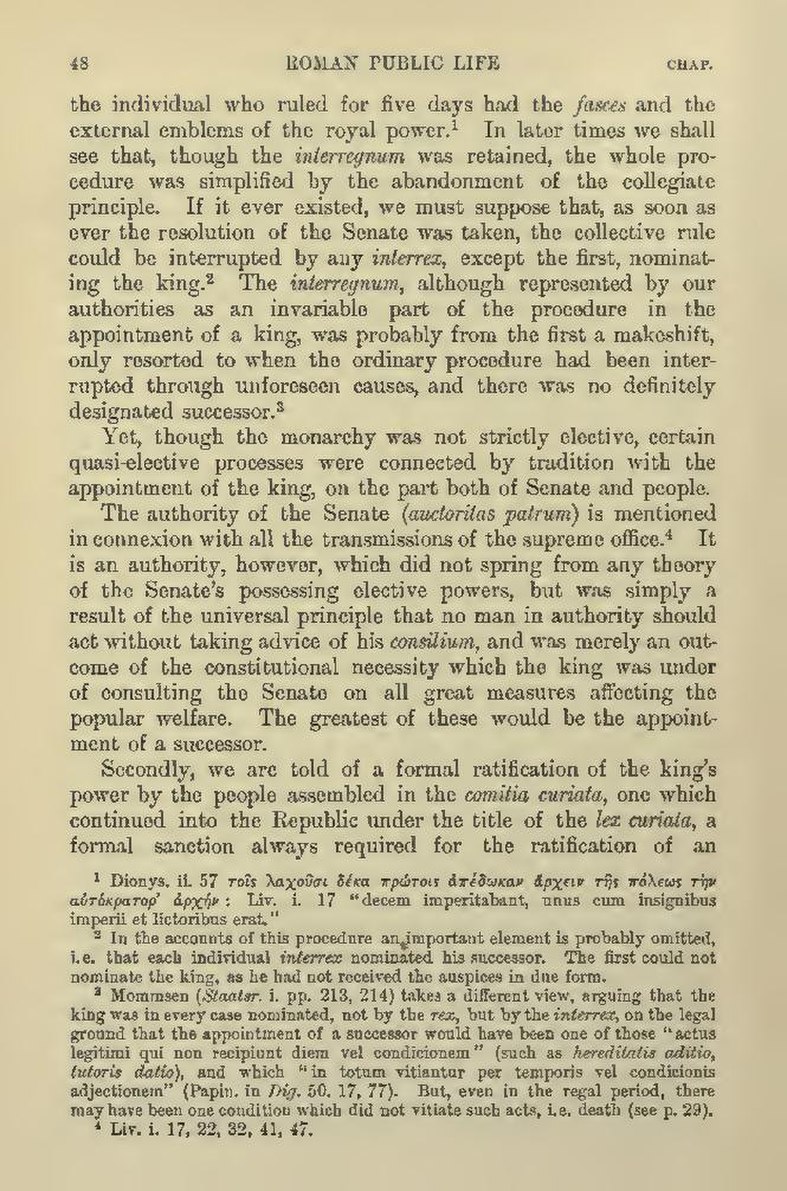the individual who ruled for five days had the fasces and the external emblems of the royal power.[1] In later times we shall see that, though the interregnum was retained, the whole procedure was simplified by the abandonment of the collegiate principle. If it ever existed, we must suppose that, as soon as ever the resolution of the Senate was taken, the collective rule could be interrupted by any interrex, except the first, nominating the king.[2] The interregnum, although represented by our authorities as an invariable part of the procedure in the appointment of a king, was probably from the first a makeshift, only resorted to when the ordinary procedure had been interrupted through unforeseen causes, and there was no definitely designated successor.[3]
Yet, though the monarchy was not strictly elective, certain quasi-elective processes were connected by tradition with the appointment of the king, on the part both of Senate and people.
The authority of the Senate (auctoritas patrum) is mentioned in connexion with all the transmissions of the supreme office.[4] It is an authority, however, which did not spring from any theory of the Senate's possessing elective powers, but was simply a result of the universal principle that no man in authority should act without taking advice of his consilium, and was merely an outcome of the constitutional necessity which the king was under of consulting the Senate on all great measures affecting the popular welfare. The greatest of these would be the appointment of a successor.
Secondly, we are told of a formal ratification of the king's power by the people assembled in the comitia curiata, one which continued into the Republic under the title of the lex curiata, a formal sanction always required for the ratification of an: Liv. i. 17 "decem imperitabant, unus cum insignibus imperii et lictoribus erat."]
- ↑ Dionys. ii. 57 [Greek: tois lachousi deka prôtois apedôkan archein tês poleôs tên autokrator' archên
- ↑ In the accounts of this procedure an important element is probably omitted, i.e. that each individual interrex nominated his successor. The first could not nominate the king, as he had not received the auspices in due form.
- ↑ Mommsen (Staatsr. i. pp. 213, 214) takes a different view, arguing that the king was in every case nominated, not by the rex, but by the interrex, on the legal ground that the appointment of a successor would have been one of those "actus legitimi qui non recipiunt diem vel condicionem" (such as hereditatis aditio, tutoris datio), and which "in totum vitiantur per temporis vel condicionis adjectionem" (Papin. in Dig. 50, 17, 77). But, even in the regal period, there may have been one condition which did not vitiate such acts, i.e. death (see p. 29).
- ↑ Liv. i. 17, 22, 32, 41, 47.
